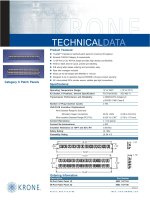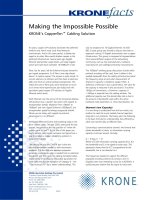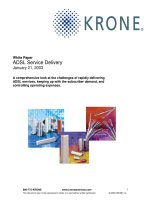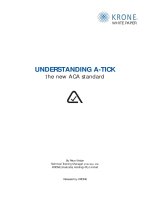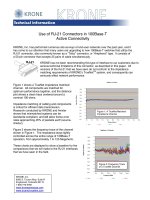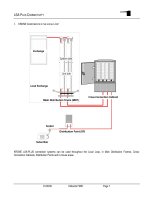Tài liệu KRONE - White paper - Testing Copper Permanent Link and Channel docx
Bạn đang xem bản rút gọn của tài liệu. Xem và tải ngay bản đầy đủ của tài liệu tại đây (76.75 KB, 8 trang )
Field Performance Testing V5 030131.doc Page 1 of 8
PERFORMANCE TESTING
OF COPPER
PERMANENT LINKS AND CHANNEL
KRONE (Australia) Holdings Pty/Ltd.
Ver. 5
Field Performance Testing V5 030131.doc Page 2 of 8
Performance Testing of Permanent Links and Channels
Testing of telecommunications Permanent Links and Channels to determine
performance compliance to Class D (using Cat 5 components) and Class E (using
Cat 6 components) is an issue that that is vital to the application for a KRONE
Warranty.
AS/NZS 3080:2002 (and ISO 11801 Ed 2) has lifted the Class D performance pass
mark from Cat 5 to Cat 5E level. This document therefore correctly refers to the
component category as Cat 5 for Class D performance in accordance with the
International Standard. In America, this same level of component performance is
still refereed to as Cat 5E.
Cat 5 (Australia & Internationally) = Cat 5E (North America)
1. Permanent Links And Channels
The fundamental building blocks for a telecommunications system are the
permanent links (PL) and channels (Ch). The field testers needed for PL testing
must nullify the effects of the test leads resulting in plug connector ends that are less
than 50 mm long. The plug connector ends are also required to meet performance
criteria that are electrically “centred”. This means that, as tester manufacturers
produce these “centred” plugs, new plugs will have to be bought for use with the
hand-held testers to obtain accurate PL test results. This requirement only applies
to PL testing. Channel testing still uses the Vendor’s patch cords, which are to be
left in situ after testing.
The configuration of the Permanent Link and Channel is shown below.
2. Passive Testing With Hand-Held Field Testers
There are currently two levels of acceptable hand-held field tester:
Level 2e – for testing of Class D and lower; and
Level 3 – for testing of Class E and lower.
90m max
100m max
Permanent Link
Channel
FD CP TO
Field Performance Testing V5 030131.doc Page 3 of 8
Level 2e Testers
This accuracy level was introduced to achieve the requirements for Class D. It
included those parameters necessary to allow data transmission on four pairs
simultaneously, as in Gigabit Ethernet. These parameters included FEXT, RL and
the calculations for ELFEXT and all POWERSUM parameters.
An increased level of accuracy and higher performance can usually be achieved by
sending the tester back to the manufacturer for a software upgrade; or by
downloading the software upgrade from the manufacturer’s web site.
The following Level 2e testers are recommended for testing for Class D
performance using Cat 5 components:
1. OmniScanner 1 & 2
2. Agilent WireScope WS155 (Software version 5.2 or higher)
3. FLUKE DSP4000 Series (4000/4100/4300)
All three work well for Class D, but there may be Return Loss problems with the
sites tested. If failures occur on RL in the field, try to use a Level 3 tester to confirm
the failure. KRONE requires that PL or Ch be tested for compliance to AS/NZS 3080
or ISO 11801 pass marks when setting up the testers with the supplied Channel
heads and Permanent Link heads.
Level 3 Testers
This accuracy level is associated with the requirements of Class E testing. Again
software upgrades are the mechanism used to keep the tester up to date with
accuracy and performance requirements. These testers are complicated instruments
and each manufacturer uses different complex mathematical algorithms in their
software to achieve the necessary accuracy and performance measurements.
The following Level 3 testers are recommended for testing of Class E
performance using Cat 6 components:
1. OmniScanner 1 & 2
2. Agilent WireScope WS350
3. FLUKE DSP 4000/4100/4300
3. Class E Warranty Testing Using Cat 6 Components
After testers have been in the field for some time, handling and maintenance issues
can arise from extended use. The Level 3 testers need to be discussed individually
as each one has unique features.
Field Performance Testing V5 030131.doc Page 4 of 8
OmniScanner 1 & 2
The OmniScanner 1 & 2 have the same base unit with one main difference: the
OmniScanner 2 has an external memory card for storing and forwarding test results:
a very handy feature to keep the tester working on-site; the OmniScanner 1 does
not. The ability to test Class E Permanent Links between the two units is the same,
provided they have the latest software version loaded. The ability to test for Class E
channels is supported by using the correct Channel head listed on the following
tables.
The PL test heads for the OmniScanner now uses the same head, lead and
Personality Module as Fluke DSP 4000 series. This means the unit has a 50 mm
lead (ie the Personality Module) there by complying with the international
requirements for test equipment.
The PL test head for the KRONE KM8 RJ45 solution must be the OMNI – LIA101 +
PM01 or PM25 Permanent Link test head.
Agilent WS350
The WS350 works well and many installers like its ease of use and high accuracy. It
has the facility for removable memory. The WS350 supports both Class E Channel
and Permanent Link testing. Older units should be checked for cable wear at the
unit interface plugs, which may cause results on RL to vary. A poor result on RL
should be investigated by using a different set of heads.
The PL test heads contain a chip that allows the unit to zero out the effects of the
test leads there by making it an effective “50 mm lead”.
Use the generic PL test head and leads for testing the KRONE KM8 RJ45 sockets.
Fluke DSP 4000, 4100 and 4300
The difference between the 4000, 4100 and 4300 models is primarily the facility for
external memory. All units give good results for testing Class E Permanent Links
and Channels.
Class E Permanent Link heads must have the new flat test cable with the new
‘Personality Module’ (a special RJ45 plug). The standard personality module PM01
comes shipped with the DSP4100 and 4300. This will change to the newer PM25
as these units become available in Australia.
The PL test head for the KRONE KM8 RJ45 socket is the generic PL test head
LIA101 + PM01 or the newer PM25.
KRONE Cat 6 patch cords must be used at both ends of a horizontal run to make up
a channel that meets the Cat 6 channel performance test requirements.
Field Performance Testing V5 030131.doc Page 5 of 8
4. Mistakes In The Field Common To All Three Testers
Out of Manufacturer’s Calibration
All testers should be calibrated by the manufacturer’s representative at least 1/year.
Yes, that means they are not available for about 10 days, so plan around this
necessary annual event.
Periodically do the self-calibration. Before the start of each new job site, then
1/week to retain confidence in the tester readings.
Incorrect NVP Setting on the Tester
NVP is essential to calculating the correct length. Do not use the default NVP.
Selecting the correct cable type on the tester will automatically select the correct
NVP.
“Star-Pass” Not Turned On
Some testers do not have the ”Star-Pass” warning activated via the tester software.
This results in a false feeling of confidence while testing because no warnings are
sounded indicating that the run needs attention. It is better to find & fix these while
staff are on site than to find out back in the office and have to return to site.
KRONE do not accept “Star-Passes” for a KRONE Warranty without consultation.
Incorrect Test Set-up & Performance Setting
Select the Test Set-up and Performance Level to the KRONE requirements as set
out in the Warranty Application Form and the builder’s project specification. If these
requirements conflict with each other, contact KRONE to get advice before you
spend days of testing time that may have to be repeated.
KRONE requirements are listed in the following tables. They are firstly the AS/NZS
3080:2002 PL & Ch requirements for Class D or E performance, or alternatively the
ISO 11801 performance parameters.
If the default North American Cat5E performance parameters are selected, then not
all the required testing and calculations will be done. (eg. Cat5E does not do ACR or
PSACR, but Class D does.)
Ware On Test Leads & Test Plugs
All of the testers have issues with Permanent Link lead and plug wear. The coiling
and uncoiling of test leads during their use over time will induce unwanted RL and
crosstalk. FLUKE & OmniScanner have specifically addressed this issue with flat
test cable for their DSP & OMNI testers. When test failures occur, a new set of
heads and test leads should be used to confirm the failure.


